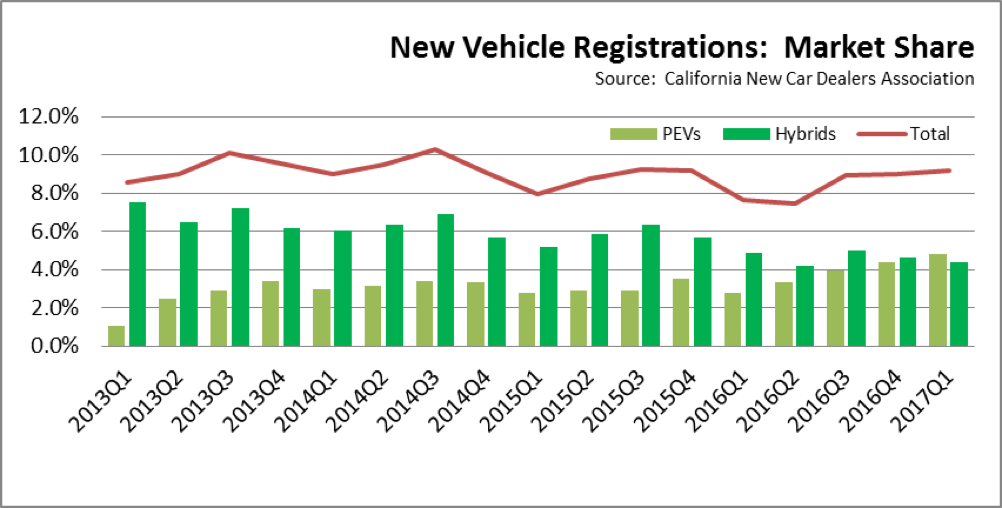The latest new vehicle sales data from California New Car Dealers Association shows continued but slowing growth in Californians’ purchases of new cars and trucks. Key findings from the data:
Light Trucks Now Half of New Vehicle Sales
- Total light vehicle sales in 2017:Q1: 506,745. Up 0.7% from 2016:Q1.
- 2017:Q1 Market share, cars: 50.2%. Down from 55.7% in 2016:Q1.
- 2017:Q1 Market share, light trucks: 49.8%. Up from 44.3% in 2016:Q1.
- California average price per gallon regular gasoline, 2017:Q1: $2.89. Up from $2.61 in 2016:Q1.

PEV Sales Up in First Quarter
- 2017:Q1 PEV sales (plug-in hybrids and battery electric vehicles) at 24,270 vehicles, up from 13,978 in 2016:Q1. Total market share for PEVs was 4.8%, up from 2.8% in 2016:Q1.
- True EV sales (battery electric vehicles) at 13,804 vehicles, up from 7,215 in 2016:Q1, with market share going from 1.4% in 2016:Q1 to 2.7% in 2017:Q1.
- Hybrid sales (except for plug-in hybrids) at 22,328, down from 24,391 in 2016:Q1. Total market share was 4.4%, down from 4.8% in 2016:Q1.
- Consumers in other states have been slow to accept California’s ZEV policies. California—with 12% of the population—accounts for 69% of all ZEV sales since 2011. Consumers in all states, however, have heavily subsidized the purchase of these ZEVs through federal tax credits and higher prices for new and used vehicles as a result of manufacturers having to purchase various regulatory credits as a result of this low market acceptance.

Cumulative PEV Sales at 19.5% of 2025 Goal
As part of the AB 32 climate change program, Executive Order B-16-2012 administratively created a goal of 1.5 million zero-emission vehicles (ZEVs) on California roads by 2025, with a sub-goal that their market share is expanding at that point. The order also established interim mileposts primarily related to infrastructure support for recharging along with more qualitative targets for manufacturing capacity and commercial viability of these vehicles.
Rather than only true ZEVs, implementation of this goal has been interpreted by the agencies as being met by both BEVs that run only on electricity and PHEVs which run on both electricity and motor fuels. Additionally, FCEVs (fuel cell electric vehicles) also would count towards the ZEV total, but to date, just over 300 have been registered in the state.
Under the agency interpretations, total PEV sales since 2009 account for 19.5% of the 2025 goal. True ZEV sales (BEVs), however, account for only 9.9%.
Previous Center updates were based on the most current Energy Commission estimates for ZEVs currently registered and actually operating on California’s roads, updated with the CNCDA quarterly sales data. The most recent Energy Commission update, however, has shifted from tracking progress based on registrations to reporting of cumulative ZEV sales based on estimates from an outside organization. The numbers, therefore, overestimate the number of ZEVs actually operating in the state by not taking into account ZEVs that have been moved out of state, traded in, involved in accidents, or otherwise removed from operation on the state’s roads. The tracking graphic below has been revised to conform to the Energy Commission’s current approach.
As an indication of the significance of this change, the previous Energy Commission estimate of registrations showed an 8% drop-off from the then-current cumulative sales number, a factor consistent with fleet-turnover rates for vehicles of this type. Applying this factor to the latest sales total, the actual progress rate consistent with the Executive Order language would be 17.8% rather than the 19.5% shown in the chart below.
Accounting for normal fleet turnover rates and reductions from persons moving out of California, PEV sales even under the revised Energy Commission approach would need to be 2.3 times as large in order to meet the 2025 goal.

Manufacturing Provisions of the Executive Order Still Not Implemented
Executive Order B-16-2012 also contains a number of provisions calling for actions to expand the ZEV and ZEV component manufacturing base in California:
- [By 2015] The State’s manufacturing sector will be expanding zero-emission vehicle and component manufacturing;
- [By 2020] The private sector’s role in the supply chain for zero-emission vehicle component development and manufacturing State will be expanding.
- [By 2025] The zero-emission vehicle industry will be a strong and sustainable part of California’s economy;
The state’s current energy costs, additional labor law restrictions and litigation risks, and lengthy permitting processes continue to limit the expansion of the ZEV related manufacturers choosing to locate within California. Rather than tackle these well-documented barriers to new manufacturing jobs, the most recent version of the ZEV Action Plan instead calls primarily for data collection and conversations:
Moving forward, state government will play a central role connecting regions to share best practices, gathering economic data to measure ZEV market growth and ensuring our workforce is trained to meet future needs.
Since the last update, the following investments have been announced to locate ZEV-related manufacturing jobs outside of California:
- In April, several carmakers including GM, Toyota, Daimler, and Volkswagen announced plans to begin EV production in China. Volvo announced plans to produce EVs in China for export worldwide. In 2016, China accounted for about half of total global EV sales and is moving aggressively to become the global center for EV production.
- In May, BMW announced expansion at its current plants to accommodate EV production. Unlike other EV manufacturers who rely on third-party parts suppliers, BMW intends to incorporate more of the parts in its own manufacturing capacity.
- In May, GAC Group announced a 200,000-car a year manufacturing facility in China.
- In May, Workhorse announced the first electric pickup truck to be built from the ground up, to be produced at its Ohio plant.
- In May, Tesla announced the debut of their solar roof tiles, to be manufactured at their Buffalo, NY plant.

